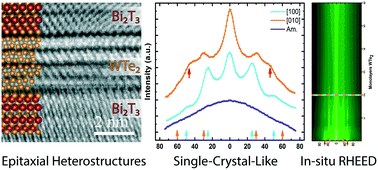Low temperature epitaxy of tungsten–telluride heterostructure films†
Abstract
Transition-metal di-chalcogenides (TMDCs) possess exceptional properties such as a direct bandgap and strong light interaction at monolayer thickness, making them excellently suited for nanoscale devices. Even more so, TMDCs can acquire unique and improved properties by stacking them with other 2D materials in van der Waals heterostructures. Currently, the growth of TMDC crystals frequently occurs using high-temperature processes like chemical vapor deposition or the Bridgman method. To comply with industrial standards, however, it is crucial to develop low-temperature procedures that ensure clean, large-area and lattice-oriented layers. Especially for a material such as WTe2, where W has an extremely high melting point, this is a difficult task. In this study, we employed pulsed laser deposition (PLD) using a single-step process at low substrate temperature (210 °C) to resolve these challenges. This deposition technique circumvents the high melting temperature of W, employing an ablation process, which yields simple stoichiometry control. By employing a seed layer of Bi2Te3, we perform WTe2 epitaxy on various substrates. The resulting films are clean and high quality 1T' phase, as verified with reflective high-energy electron diffraction (RHEED) and transmission electron microscopy (TEM). The reported methods allow for fabrication of TMDC thin films for devices, and furthermore shows that PLD is excellently suited for epitaxial growth of these 2D heterostructures.



 Please wait while we load your content...
Please wait while we load your content...